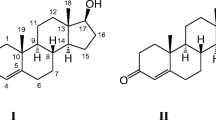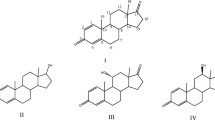Abstract
The ability of the ascomyceteAspergillus niger N402 to transform exogenous progesterone was investigated. We found that this strain has steroid-hydroxylating activity and can introduce a hydroxyl group into the progesterone molecule mainly at positions C11(α) and C21 with predominant formation of 21-hydroxyprogesterone (deoxycortone). In addition, formation of 6β,11α-dihydroxyprogesterone was also observed. Studying the effects of the growth medium composition and temperature on progesterone conversion by A. niger N402 showed that the most intense accumulation of 21-hydroxyprogesterone occurred in minimal synthetic medium at 28°C. Increasing the cultivation temperature to 37°C resulted in almost complete inhibition of the hydroxylase activity in the minimal medium. In the complete medium, a similar increase in temperature inhibited 11α-hydroxylase activity and completely suppressed 6β-hydroxylase activity, but it produced no effect on 21-hydroxylating activity.
Similar content being viewed by others
Abbreviations
- CM:
-
complete medium
- HRMS:
-
high-resolution mass spectrometry
- MM:
-
minimal medium
- NMR:
-
nuclear magnetic resonance
- TLC:
-
thin-layer chromatography
References
Mashkovsky, M. D. (2005) Drugs: Handbook for Physicians [in Russian], Novaya Volna, Moscow, pp. 579–580.
Numazawa, M., and Nagaoka, M. (1983) A facile synthesis of deoxycorticosterone using the controlled alkaline hydrolysis of 21-bromo-20-ketopregnenes, J. Chem. Soc. Chem. Commun., 3, 127–128.
El-Kady, I. A. (1982) 6b-Hydroxylation of steroids by extracts of Aspergillus niger, J. Gen. Microbiol., 128, 2511–2514.
Fouad, W. A., Abbas, I. H., Elwan, K. M., Swellum, M. A., and El-Dougdoug, Kh. A. (2009) Biotransformation of progesterone by microbial steroids, J. Appl. Sci. Res., 35, 137–143.
Metwali, M. R. (2002) Microbiological transformation of progesterone to 21-hydroxyprogesterone by Aspergillus niger (isolate No. 11/3), Bulletin of the Faculty of Science, Assiut University, D Botany, 31, 313–318.
Koolman, J., and Rohm, K.-H. (2009) Taschenatlas der Biochemie, Thieme.
Bos, C. J., Debets, A. J. M., Swart, K., Huybers, A., Kobus, G., and Slakhorst, S. M. (1988) Genetic analysis and the construction of master strains for assignment of genes to six linkage groups in Aspergillus niger, Curr. Genet., 14, 437–443.
Capek, A., Tadra, M., and Tuma, J. (1964) Microbial transformations of steroids XXIV. Separation of androstane 17-hydroxy-epimers, Folia Microbiol., 9, 380–382.
Yildirim, K., and Kuru, A. (2015) Biotransformation of some steroids by Aspergillus candidus, J. Chem. Res., 39, 546–549.
Hosseinabadi, T., Vahidi, H., Nickavar, B., and Kobarfard, F. (2015) Biotransformation of progesterone by whole cells of filamentous fungi Aspergillus brasiliensis, Iran J. Pharm. Res., 14, 919–924.
Habibi, Z., Yousefi, M., Ghanian, Sh., Mohammadi, M., and Ghasemi, S. (2012) Biotransformation of progesterone by Absidia griseolla var. igachii and Rhizomucor pusillus, Steroids, 77, 1446–1449.
El-Refai, A. H., and Ghanem, K. M. (1987) Some physiological relations of progesterone conversion by Aspergillus nidulans, Egyptian J. Microbiol., 22, 327–338.
Schomburg, D., and Schomburg, I. (2006) Springer Handbook of Enzymes. Vol. 27. Class 1–Oxidoreductases XII, 2nd Edn., Springer Verlag, Berlin, p. 302.
Samanta, T. B., and Ghosh, D. K. (1987) Characterization of progesterone 11 alpha-hydroxylase of Aspergillus ochraceus TS: a cytochrome P-450 linked monooxygenase, J. Steroid Biochem., 28, 327–332.
Kim, M.-N., Lee, Y.-J., and Lee, H.-H. (1985) Steroid modification with Aspergillus phoenicis. Effects of reaction temperature and sonication, Kor. J. Mycol., 13, 83–87.
Author information
Authors and Affiliations
Corresponding author
Additional information
Original Russian Text © O. S. Savinova, P. N. Solyev, D. V. Vasina, T. V. Tyazhelova, T. V. Fedorova, T. S. Savinova, 2018, published in Biokhimiya, 2018, Vol. 83, No. 1, pp. 71-77.
Originally published in Biochemistry (Moscow) On-Line Papers in Press, as Manuscript BM17-361, November 20, 2017.
Rights and permissions
About this article
Cite this article
Savinova, O.S., Solyev, P.N., Vasina, D.V. et al. Biotransformation of progesterone by the ascomycete Aspergillus niger N402. Biochemistry Moscow 83, 26–31 (2018). https://doi.org/10.1134/S0006297918010030
Received:
Revised:
Published:
Issue Date:
DOI: https://doi.org/10.1134/S0006297918010030




